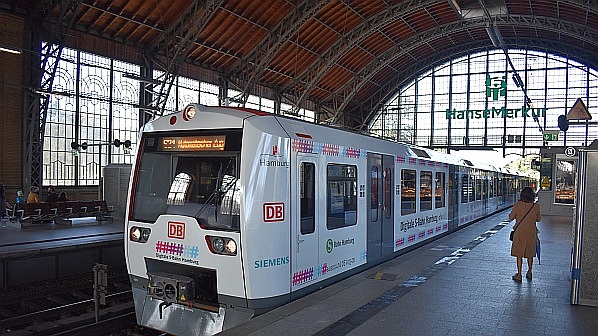GERMAN Rail (DB) and Siemens Mobility unveiled the first S-Bahn train that operates autonomously by using ATO over ETCS in Hamburg on October 11.
DB CEO, Dr Richard Lutz, Siemens CEO, Dr Roland Busch, and Hamburg mayor, Dr Peter Tschentscher, all travelled on the first trip from Hamburg Dammtor to Bergedorf, which demonstrated highly-automated and fully-automated operation on the 23km section of Lines S2/S21 from Berliner Tor to Aumuhle.
While the train operated on the mainline at GoA2 with a driver present in a supervisory capacity, when the train reached Bergedorf, it shunted to sidings and returned to the station at GoA4 without a driver onboard.
Train control information data is transmitted over a 5G network developed as part of the Digital S-Bahn Hamburg project involving Alstom, Nokia and Vodafone. The existing electronic interlocking in Bergedorf has been equipped with the latest technology from Siemens Mobility for ATO deployment over ETCS. There is a new radio block centre located in the Bergedorf interlocking building.
Siemens says the technology will enable DB to operate up to 30% more trains as well as improve energy efficiency. In addition, the trains learn to optimise their own operation. This will also allow the company to deploy the system across Europe and the world.
Four class 474 S-Bahn trains will start passenger operation in Hamburg this December. The equipment is fitted in a box under the middle car which means no passenger capacity is lost and retrofitting is easier than more invasive modifications to the trains. Plans to automate the city’s full S-Bahn network are underway with the aim to complete this by the end of the decade.
DB, Siemens Mobility, and the City of Hamburg have invested €60m in the digital S-Bahn Hamburg project, which is part of DB’s Digital Rail Germany project.
“Today we’re experiencing the true turn of an era,” Lutz says. “With automated rail operations, we can offer our passengers a significantly expanded, more reliable and therefore improved service - without having to lay a single kilometre of new track. It is our goal to make rail transport attractive to ever-larger numbers of people, which is the only way we can achieve the mobility transition.”
“We are making rail transport more intelligent,” Busch says. “Trains drive the perfect timetable automatically, accurate to the second and energy-optimised.”

